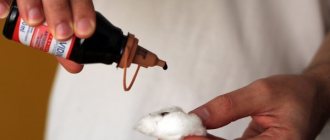Domestic cats are quite willful animals, mindful of themselves, not to mention those that are forced to survive on the street for a long time. Therefore, when a person comes face to face with this sweetest creature, one must keep one's ears open. All you need to do is pet him the wrong way, scratch him in the wrong place, and sometimes even look at him tenderly enough, and this furry baby will turn into an angry tiger. One second and the cat has already grabbed your hand. It seems that the wound is not serious, but you have to think if a cat has bitten you and your hand is swollen, what to do.
How dangerous is a cat bite for humans?
The consequences of a cat bite can take a very long time to treat, so if possible it is necessary to prevent the occurrence of such a problem. But if a situation does occur and a domestic cat bites you, you cannot relax. Of course, compared to street walking, the chances of contracting a serious disease are less, but this does not mean that you can turn a blind eye to this incident. In the case of an outdoor cat, the possible consequences can be very dangerous, and even fatal. At first glance, there is no way for a domestic cat to pick up the infection, so he cannot pass it on to the one who has been bitten. But this is not true; after a bite from any cat, various symptoms with complications can occur, and the consequences can be sad. However, statistics show that even if a cat transmits the infection through a bite, the amount of bacteria will not be enough to initiate an inflammatory process.
Only if the immunity is already weakened, or the victim already has an external infectious disease, the chances of infection increase. There are several options for the development of inflammation: bacterial infection, tetanus and, worst of all, rabies. Let's take a closer look.
Bacterial infection
The most common bacterium that infects humans after a cat bite is considered to be Pasteurella multocida. In the absence of adequate treatment, it can provoke the occurrence of a disease such as pasteurellosis. These pathogenic microorganisms are also capable of interacting with the pathogens streptococcal and staphylococcal bacilli. It is because of this that the hand turns red after a cat bite, and then it swells. Thanks to the swelling, these inflammatory processes are quickly diagnosed and treatment is prescribed. The main thing is to see a doctor within 24 hours.
After a bite from an outdoor cat, another unpleasant “cat scratch” disease can develop - lymphoreticulosis. However, not only scratches, but also bites can cause the development of an inflammatory process in the lymph nodes. Even if a cat bites your finger, the lymph nodes located in the neck area may swell. In the absence of adequate treatment, the disease can quickly develop and result in damage to the nervous system.
Tetanus or how not to die from a simple scratch
Even if at first glance it seems that nothing serious has happened, but the bite or scratch appears to be deep, or if there is a lump under the skin, you should immediately consult a doctor. After treating the wound, the doctor will check when the last tetanus shot was given. If it has not been present in the last 10 years, then urgent vaccination is necessary.
If within 10 days after the bite you become ill or begin to behave inappropriately, this poses a serious threat. In this case, the doctor administers a second injection of rabies immunoglobulin.
If the swelling goes away and no secretions come out of the wound, then nothing else needs to be done to the hand.
Rabies
It is important to know that if you are bitten, especially by an outdoor cat, you can contract an almost incurable disease - rabies. A domestic cat can also be dangerous if it goes outside or interacts with other unvaccinated animals. The victim has three days to take measures to save him from death. Rabies is transmitted through the saliva of an infected cat. Signs of the disease in cats usually appear almost immediately:
- aggressive behavior;
- severe drooling;
- fear of light and sharp sounds;
- inadequate reaction to the presence of people;
- loss of appetite and excessive excitability.
If you detect even one sign of rabies in a cat, you must immediately consult a doctor for urgent vaccination. The pet must be isolated for two weeks.
What is the danger of bites
Although cats are predators by nature, the size of their claws and teeth is not so large as to pose a serious threat to human life. However, cat bites can cause significant harm to health. The danger in this case lies in
the following reasons and factors:
- The naturally sharp teeth of a seemingly small animal contribute to serious damage to soft tissues.
Epithelial ruptures lead to pain and decreased joint mobility if it occurs in the articular area. Deep and closed wounds are an excellent environment for the development of inflammation and suppuration.
- The presence of a huge number of bacteria and viruses in the animal’s mouth. Even a pet cannot boast of the absence of microorganisms in the oral cavity. When bitten, the bacilli enter deep into the skin tissue and cause an inflammatory reaction in the form of swelling or swelling in the damaged area. If the cat has bitten severely and the hand is swollen, then this phenomenon indicates infection of the deep tissues by microorganisms.
- Some animals are carriers of the causative agent of benign lymphoreticulosis (cat scratch disease) . In this disease, chlamydia, which is a pathogenic microorganism, penetrates human tissue not only through scratches, but also through bites. In the first stages of the disease, the site of injury may be swollen and red, and then a generalized infection develops that affects the body's lymphatic system.
Cat scratch disease
- In addition to pathogenic chlamydia, cats are often carriers of the causative agent of pasteurellosis. In this case, an animal bite can lead to septic symptoms due to streptococcal or staphylococcal infection.
- If you are bitten by a stray cat or an animal with access to the street, there is a risk of contracting tetanus. Cat bites are deep and the wound surface heals quickly. This promotes the development of anaerobic conditions for the tetanus pathogen.
- The danger of bites from stray and street animals is due not only to the development of an inflammatory reaction from soft tissues, but also to the risk of contracting rabies. The virus of a fatal disease is transmitted through the saliva of a sick animal, most often through bites.
- Weak immunity, the presence of concomitant diseases, and lack of treatment can lead to sepsis .
Despite the small size of the cat, you should not be dismissive of pet bites, especially if the injury was caused by a stray animal or after a domestic cat has bitten and the hand has become swollen.
To learn about what cat scratch disease is, watch this video:
A cat bit me, what should I do?
Any cat, both indoor and outdoor, is capable of biting a person’s hand, especially if it gets angry. What to do if bitten by a domestic cat?
Most often, the consequences of a bite pass quickly enough, even if there was blood at the beginning. But to prevent your hand from swelling after a cat bite, you can do a number of things at home:
- If the skin is damaged, place your hand under cold running water and hold it there for five minutes. This action will wash the wound and relieve pain.
- Use soap, preferably laundry soap, to remove dirt or dust.
- After which the wound must be cauterized with hydrogen peroxide.
- When the bleeding has completely stopped, antibacterial ointment can be applied to the wound.
It is important to know that bleeding in the event of a cat bite is only beneficial, since the cat’s infection comes with the blood.
If, a day after the cat bite, signs of infection appear, your hand is swollen, and your fingers are swollen, you should start taking antibiotics: doxycycline, ciprofloxacin, ceftriaxone. From the above list, only ceftriaxone can be used by pregnant women.
What is the likelihood of contracting rabies from a cat bite?
The likelihood of contracting rabies from a vaccinated domestic cat is low, but it still exists for the following reasons:
- Cases of rabies have been reported in this area.
- The vaccination expires.
- The vaccine has expired.
- The temperature regime was violated during transportation or storage.
Be sure to read:
What causes growths on the pads of cats front or back paws?
If an unfamiliar cat bites in the yard or on the street, the chances of infection increase. It is unknown whether this animal has been vaccinated. Even if the area is rabies-free, the infection can be spread by mice or rats.
A cat can become infected not only from a rodent bite. The mad mouse becomes bolder, is not afraid of the cat and is even ready to attack him. The cat eats the insolent and becomes infected with rabies.
When to see a doctor
If first aid was provided correctly, then in most cases medical intervention is not required. If a cat has bitten you and your hand is swollen, the bleeding does not stop for 10 minutes or more, the wound is very painful and there is discharge from it, there is a fever or anaphylactic shock. If it turns out that the cat that bitten was infected with something, and the hand was swollen. In these cases, you should immediately go to the hospital.
Which doctor should you contact after a cat bite? In this case, you need to go to the emergency room. After carrying out the necessary studies, you will be referred to either a surgeon or an infectious disease specialist.
How is a cat bite different from a dog bite?
A cat, unlike a dog, cannot seriously harm. The jaws of domestic cats are small and weak, the teeth are small, and significant injury is unlikely. However, a cat bite can pose a serious danger.
Cat bite
Dog teeth usually injure the skin and soft tissue more severely, but dog bite marks heal faster and easier than cat bites. This is due to the characteristics of the microflora contained in the cat's mouth. A cat's saliva contains microorganisms that can cause inflammation in the wound, slowing down the healing process.
The short but sharp teeth of a domestic cat penetrate deep into the skin and into the soft tissue underneath, infecting the wound. If you are bitten by a cat and your leg is swollen, you may need to take antibiotics.
Externally, a wound from a cat's teeth can be misleading. Unlike a dog’s teeth, the marks from a cat’s teeth are pinpoint, but penetrate deep into the soft tissue, damaging muscles or tendons. A bite to the joint area is especially dangerous.
The unpleasant thing is that the bite site takes a long time to heal. As a rule, the wound is healed by an unaesthetic scar, and the part of the body that was bitten by the cat receives a cosmetic defect for life. The bite and deep scratches from the claws remain on the surface of the skin.
How to treat a bite at home
What to do if you are bitten by a cat and there is no way to see a doctor. There are many ways to give yourself first aid. If a cat has bitten your finger and it is swollen, you should wash it with running water, preferably with soap. After which the cat bite should be treated with hydrogen peroxide, and then with an antiseptic ointment. You can use Vishnevsky ointment. It is possible to cure a cat bite at home only if the wound is not deep and the animal is vaccinated. In other cases, it is better to seek qualified help. If you decide to treat the bite at home, treat the injury site as often as possible, preferably after each contact with water.
No matter how cute the purring street cat may seem, try to avoid it. If this is not possible, do not provoke aggression in the poor creature with your obsessive caresses. Outdoor cats are not accustomed to displays of love and tenderness, so they may perceive your hand as an act of attack on their territory.
Take the necessary preventive measures to combat dangerous diseases - rabies and tetanus. And then you will be able to fearlessly communicate with cats and cats.
Galina Polovnikova / author of the article
I write articles in various areas that, to one degree or another, affect such a disease as edema.
In what cases is medical help needed?
If the arm or leg that was bitten by a cat is red, swollen and painful, this is a reason to immediately seek medical help. Self-medication will lead to serious complications until the damaged limb is removed.
Redness after a bite
If you are bitten by a cat, you should contact a medical facility in the following ways:
- A bite with a large area and depth of damage.
- A joint or the area of the neck and face, or the scalp has been bitten.
- Heavy bleeding that cannot be stopped for more than a quarter of an hour.
- Deterioration of general health, malaise.
- Chills, fever, high temperature.
- The wound hurts, is red and swollen.
- If you are bitten by a stray cat or an unvaccinated domestic cat that has free access to the street.
If one of the listed symptoms appears, you need to go to the emergency room. Preferably within 12 hours after injury.
As a rule, the area of the bite wound is treated with an antiseptic solution. If necessary, apply a bactericidal dressing.
Observe the condition of the victim for at least two days. If within 24 hours the wound has not turned red or swollen, body temperature and general health remain unchanged, the bite is treated without prescribing antibacterial therapy.
An antibacterial drug with a broad spectrum of action is usually prescribed.
In each case, after a cat or dog bite, especially an unknown one, a tetanus vaccination is given at the trauma center. The victim is given a special tetanus vaccine according to a specific schedule. If indicated, an additional rabies vaccination is given.
Visiting a trauma center











